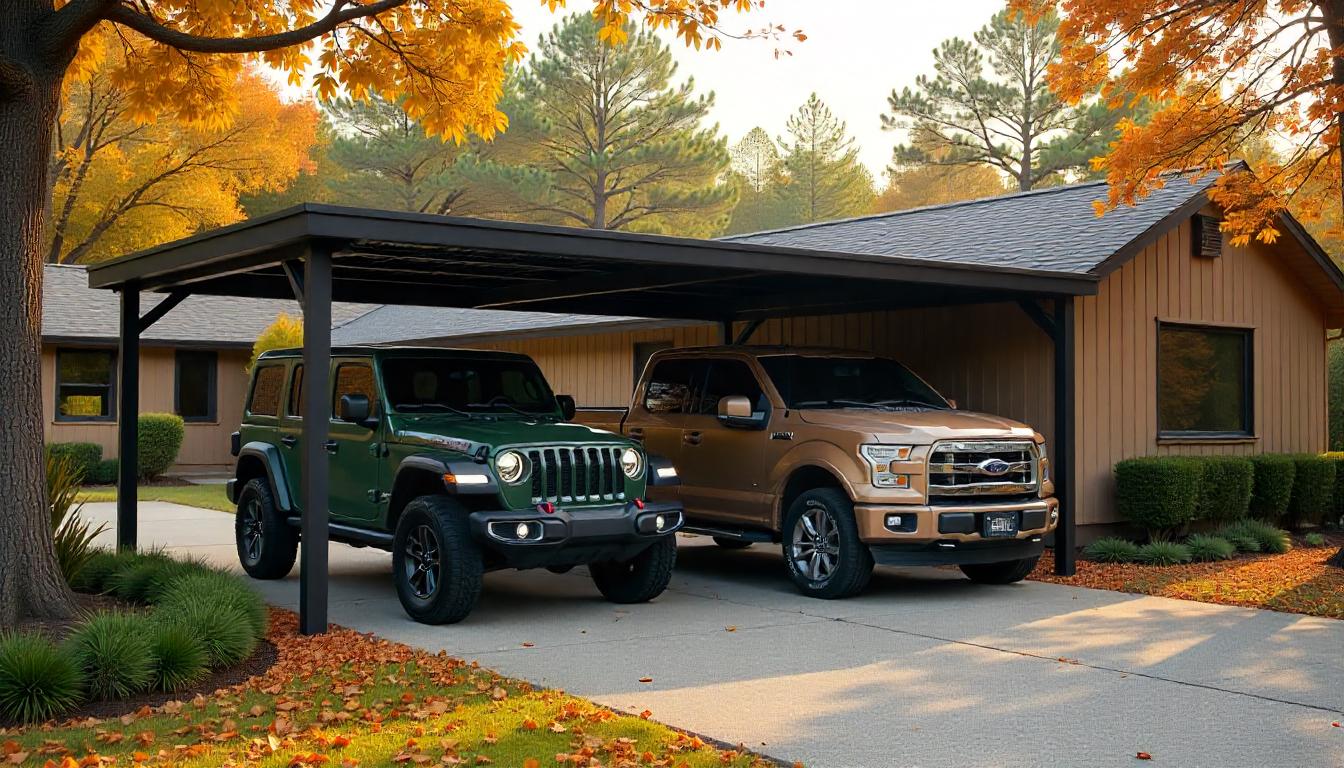
Top 10 Tips to Choose the Perfect Aluminum Carport for Your Home (Expert Guide)
Choosing the perfect aluminum roof carport for your home involves much more than just picking a structure to park your car under. A well-chosen aluminum carport adds value, boosts curb appeal, and protects your vehicle or equipment for years to come. With so many designs, materials, and options on the market, it can be tricky to decide what’s best. This guide walks you through everything you need to know—from planning and sizing to features and installation—so you can make a confident decision. By Design Aluminum Patio
Understanding the Benefits of an Aluminum Carport
Durability and Rust Resistance
Aluminum is naturally resistant to rust, making it an ideal choice for outdoor structures. It doesn’t rot, warp, or corrode over time, which means less maintenance and longer life compared to wood or steel.
Lightweight Yet Strong
Despite being light, aluminum is incredibly strong. Its structural integrity allows for broad spans without the need for excessive supports, providing more usable space underneath the carport.
Low Maintenance Needs
Aluminum doesn’t require painting or sealing. A quick wash with water and mild detergent every few months is usually all it takes to keep it looking fresh and clean.
Assessing Your Space and Needs
Measuring Available Space
Start by measuring the area where you plan to install your carport. Consider not just length and width, but also height, clearance from other structures, and room for door or trunk opening.
Determining Carport Usage
Are you only parking a vehicle, or do you need extra room for storage, a boat, or an RV? Knowing how you’ll use the carport helps determine the size, type, and features needed.
Choosing the Right Carport Size
Standard Sizes for One, Two, or More Vehicles
Single Car: 12′ x 20′
Double Car: 20′ x 20′ or 22′ x 24′
RV/Boat: 12′-18′ wide, 30′-40′ long
Clearance Height Considerations
Ensure the height accommodates your vehicle, especially if you have a truck with a rack or an RV. A minimum clearance of 7 feet is standard, but adjust based on your needs.
Roof Style Options and Their Benefits
Gable Roof vs. Flat Roof
Gable Roofs: Offer better water drainage and a more traditional appearance.
Flat Roofs: Simpler and cost-effective, but may require more maintenance in heavy rainfall areas.
Snow Load and Rain Management
If you live in an area with heavy snow or rain, a sloped or gable roof is ideal. Look for aluminum carports rated for snow load and with built-in drainage channels.
Freestanding vs. Attached Carports
Advantages and Limitations of Each Type
Freestanding: Greater flexibility, no need to modify your home’s structure.
Attached: Saves space, offers seamless transition from house to carport.
Structural Considerations
Attached carports must be securely fixed to your home’s framing. Consult with a contractor to ensure your structure can handle the load.
Local Building Codes and Permits
Why Permits Are Crucial
Most cities require a permit for permanent structures. Skipping this step could lead to fines or forced removal.
HOA Rules and Compliance
Check with your homeowner’s association for design guidelines, color restrictions, and placement rules before you start building.
Selecting the Best Aluminum Grade and Finish
Coated vs. Non-Coated Aluminum
Choose powder-coated aluminum for increased durability, resistance to chipping, and a cleaner look.
Color and Aesthetic Choices
Modern carports come in neutral tones like white, black, and gray, which blend well with most homes. Some offer wood-look finishes for added style.
Anchoring and Foundation Requirements
Concrete Slabs vs. Ground Anchors
Concrete Slab: Most stable and permanent option.
Ground Anchors: Ideal for temporary or semi-permanent setups.
Site Preparation Tips
Level the ground, remove vegetation, and install drainage if necessary. For concrete foundations, allow curing time before installation.
Insulation and Weatherproofing Options
Enclosed Carports and Side Panels
Adding side panels or enclosure kits helps protect against wind, rain, and snow. Some kits even offer doors for full enclosure.
UV and Rain Protection Features
Look for carports with UV-treated roofing or polycarbonate panels to protect your vehicle from sun damage and rain.
Budgeting and Cost Considerations
DIY Kits vs. Professional Installation
DIY Kits: $1,000–$3,000 depending on size and features.
Professional Install: $3,000–$8,000+ including labor and site prep.
Long-Term Value vs. Upfront Cost
Aluminum carports may have a higher upfront cost but save money long-term due to low maintenance and durability.
Customization and Add-On Features
Gutters, Storage, and Lighting
Gutters: Prevent erosion and protect the foundation.
Storage Units: Add sheds or lockers for garden tools and equipment.
Lighting: Solar or wired lights improve safety and usability at night.
Solar Panels and Eco-Friendly Additions
Some aluminum carports are designed to support solar panels, letting you harness clean energy while sheltering your car.
Comparing DIY Carport Kits vs. Professional Installation
Tools, Time, and Skills Required
DIY kits require basic tools and 1–2 days of labor. Make sure you’re comfortable with reading plans and using power tools.
Warranty and Longevity Differences
Professionally installed carports often come with extended warranties and are less prone to installation errors.
Trusted Aluminum Carport Manufacturers
What to Look for in a Reliable Brand
Years in business
Positive reviews
Warranty offerings
U.S.-based manufacturing
Customer Reviews and Support
Choose brands with responsive customer support and detailed installation guides or videos.
Maintenance Tips for Aluminum Carports
Cleaning and Upkeep
Clean with mild soap and water every 3–6 months. Avoid abrasive cleaners that can damage the finish.
Seasonal Checks and Repairs
Inspect for loose bolts, debris on the roof, and damage after storms. Tighten connections and reapply sealant as needed.
Common Mistakes to Avoid
Ignoring Local Regulations
Permits and zoning rules exist for a reason. Check with your city before installation to avoid future headaches.
Underestimating Size or Load Needs
Better to go slightly bigger than too small. Think ahead to future vehicles or storage needs.
Frequently Asked Questions (FAQs)
1. Can I install an aluminum carport on grass?
Yes, but it’s not recommended. A concrete base or gravel pad ensures stability and prevents rusting of anchoring parts.
2. How long does an aluminum carport last?
With proper care, they can last 20–30 years or more.
3. Are aluminum carports noisy in the rain?
Some noise is natural, but adding insulation or using coated panels can reduce the sound significantly.
4. Do I need a building permit?
In most cases, yes. Always check with your local authorities before starting construction.
5. Can I move my aluminum carport later?
Freestanding models are often movable, but it depends on how they’re anchored.
6. Are aluminum carports fire-resistant?
Aluminum has a high melting point and is considered fire-resistant compared to wood or vinyl.
Conclusion: Final Tips for Choosing the Best Aluminum Carport
Choosing the perfect aluminum carport for your home involves more than just style and price—it’s about matching your lifestyle, space, and climate needs. Take time to measure, compare options, check local regulations, and invest in quality materials. With the right setup, your aluminum carport will provide years of reliable protection, convenience, and curb appeal. Get in touch with us, we can help you build your custom made aluminum carport
